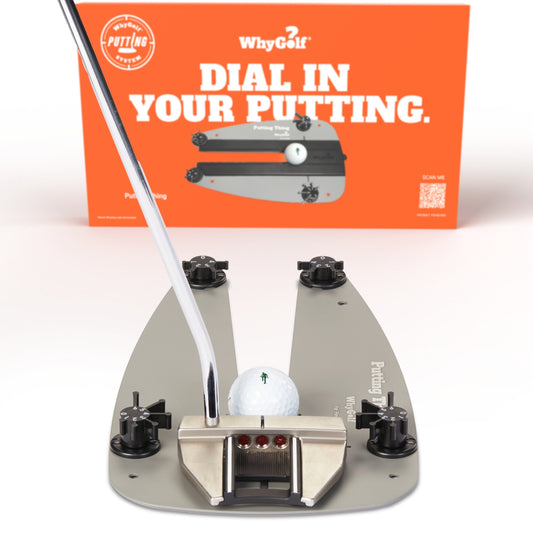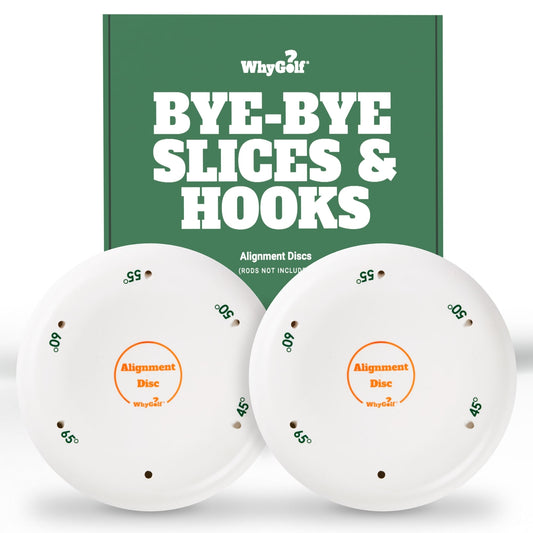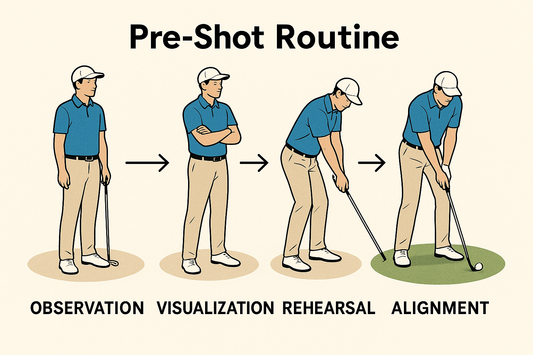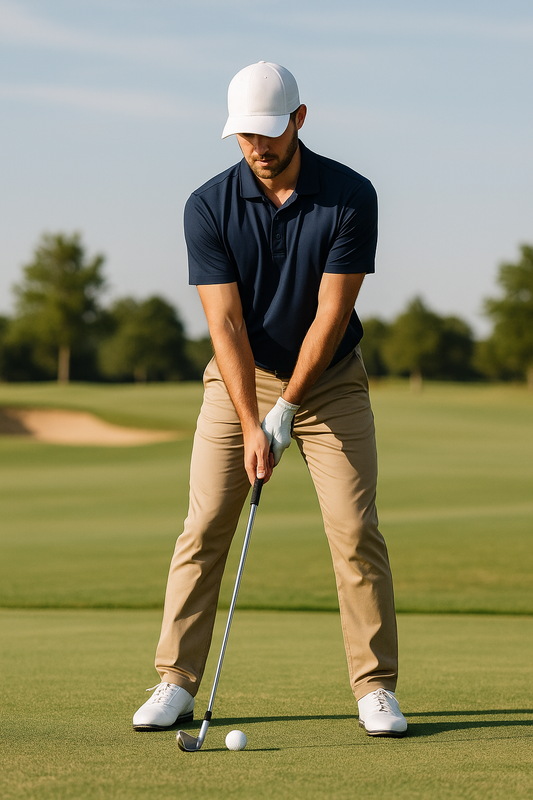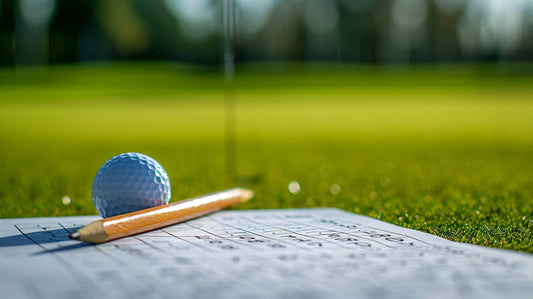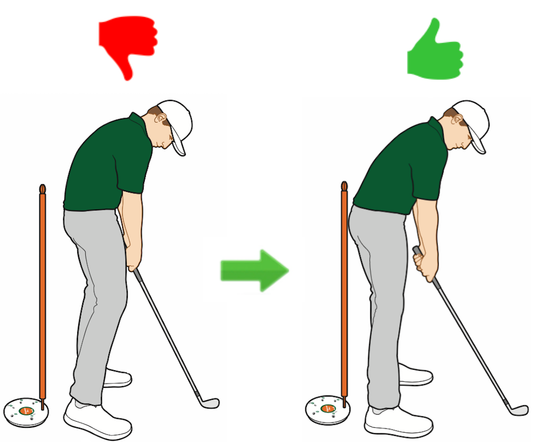Author: WhyGolf WhysGuy
We want to preface this guide with the acknowledgment that neither WhysGuy nor anyone from the WhyGolf team claims to know everything about the golf swing. We don’t want anyone to treat what we say here as gospel. While much of what we’ll say is a reflection of decades of dialogue with PGA instructors and players, we’re always learning and we understand that knowledge about the sport of golf will continue to evolve over time.
In this post, WhysGuy will cover:
- What a cupped wrist is in the golf swing and why a cupped lead wrist can lead to inconsistencies.
- While a cupped lead wrist isn't necessarily a swing flaw, we designed a device to let you know when your wrist does cup.
- How you can use ArmAlarm's Wrist Clip to work on keeping your lead wrist flat.
1. Apply WristAlarm to Your Lead Wrist
WristAlarm (included with purchase of ArmAlarm) is a small magnetic clip that attaches to the ArmAlarm's magnet case. Attach the Wrist Clip to the inside part of your glove as shown in the adjacent illustration. Attach the clip so it reaches past your glove's inseam. This will ensure that the clip will remain in place when your wrist moves.
We recommend golfers place the ArmAlarm magnet case about where you would wear a typical wrist watch.
2. WristAlarm Will Beep When You Cup Your Wrist
If you cup your lead wrist, the magnets will disconnect and the alarm will sound. When your wrist returns to a neutral position, the magnets will return to their original position. If you find that your wrist clip is not attached securely to your glove, it's worth ensuring that your clip is attached beyond your glove's inseam as shown in the adjacent illustration.
If you cup your wrist and the magnets do not separate, this is an indication that your ArmAlarm magnet case is too close to your glove. To increase sensitivity, we recommend moving your magnet case slightly up your forearms.
3. Don't Let Your Lead Wrist Cup with WristAlarm
When you arrive at the top of the backswing with WristAlarm attached to your glove, you will know instantly when your lead wrist cupped. This auditory feedback will guide you into your desired wrist position.
We absolutely recommend that players hit golf balls with WristAlarm. It's so common that players make great practice swings, then totally fail to move as desired when trying to hit a golf ball. WristAlarm is a phenomenal tool to help players feel what a flat wrist is supposed to feel like in real-time. If you can bridge the gap between what you feel and what is real, you're on your way to making swift swing changes!
4. If WristAlarm Doesn't Sound, Your Lead Wrist is Flat!
We recommend practicing your backswing with WristAlarm until you find yourself naturally keeping your lead wrist flat. This will take days for some and months for others, depending on how often one is able to practice.
Much progress can be made practicing within one's house without a golf ball. A few swing iterations a day in the living room can make a world of a difference over time! Send us your before and after photos to info@whygolf.com!
Cupped Lead Wrist - Key Takeaways:
- A cupped lead wrist, though not necessarily a swing fault, can often make it difficult for a golfer square the clubface at impact.
- If a golfer wants to rid themself of a cupped wrist in their golf swing, the WhyGolf WristAlarm (sold together with ArmAlarm) is the simplest and easiest way to address this common swing issue.
Ready to make an investment in your golf swing? Learn more about how the ArmAlarm (with WristAlarm) can revamp your golf game here.
What is a cupped wrist in golf swing?
A cupped lead wrist is a common golf swing flaw that can result in inconsistent ball striking, loss of distance, and an increased risk of injury. When the lead wrist is cupped, it indicates that the back of the lead hand is arched and the wrist is weak. This can result in a more open clubface at impact, resulting in a slice or a weak shot. Golfers can improve their ball striking consistency and accuracy by repairing a cupped lead wrist, resulting in higher scores on the course. A flat lead wrist can also lower the risk of wrist and hand injuries caused by the strain of an overly cupped wrist during the swing.
How do I fix a cupped wrist in golf swing?
The WhyGolf WristAlarm (part of ArmAlarm and sold together) is your best bet. Golfers can correct a cupped wrist by maintaining a flat or slightly bowed lead wrist throughout the swing while using WristAlarm. Golfers can also work on their grip and hand positioning to avoid a cupped wrist. A neutral grip and proper hand placement can aid in the promotion of a more natural and consistent lead wrist position throughout the swing. Fixing a cupped wrist in the golf swing takes time and practice, but it can lead to more consistent ball striking and overall performance improvement on the course.
What is a bowed wrist in golf swing?
In the golf swing, a bowed wrist is the inverse of a cupped wrist. A cupped wrist has an upwardly bent wrist, whereas a bowed wrist has a downwardly bent wrist. In the golf swing, a bowed wrist is typically preferred because it promotes a more consistent strike and reduces the risk of hitting thin shots.
When the lead wrist bows at impact, the clubface is able to square up more easily, resulting in more accurate shots. It also promotes a stronger impact position and a downward strike on the ball, resulting in better ball flight and increased distance.
Golfers should focus on keeping their lead wrist flat or slightly bowed throughout the swing to achieve a bowed wrist at impact. This is achieved by keeping a firm grip on the club and keeping the lead arm straight throughout the swing.
A bowed wrist should not be overdone, as too much bending can result in a hook or a closed clubface at impact. To find the right amount of wrist bowing for your swing, consult with a qualified golf instructor.
Is a cupped wrist always a bad thing?
Definitely not. Many great golfers throughout history have played golf from a cupped lead wrist position. However, we can only notice that most golfers playing professionally today don't cup their lead wrist, which leads us to believe that if you're cupping your wrist, it may be worth considering making a change to a more neutral position. Excessive cupping of the lead wrist can result in inconsistent shots and a loss of accuracy. It can also strain the wrist and cause injury. It is critical to remember that each golfer's swing is unique, and what works for one may not work for another. Working with a golf coach to determine the best wrist position for your individual swing is essential.
Does a bowed or cupped lead wrist lead to more consistency in golf?
Both techniques have advantages and disadvantages, and it ultimately comes down to personal preference and swing characteristics.
A cupped wrist can result in a more wristy and inconsistent swing. Some golfers, however, find that cupping the wrist helps them generate more lag and power. But a cupped wrist can often lead to slices.
A bowed wrist, on the other hand, in which the lead wrist is slightly flexed inwards towards the target at the top of the backswing, can result in a more consistent and controlled swing. It can assist golfers in avoiding clubhead flipping at impact, resulting in greater accuracy and distance control. Finally, the best approach is to try both techniques and see what works best for you!
Check Out Our YouTube Channel For Drills and Tips



